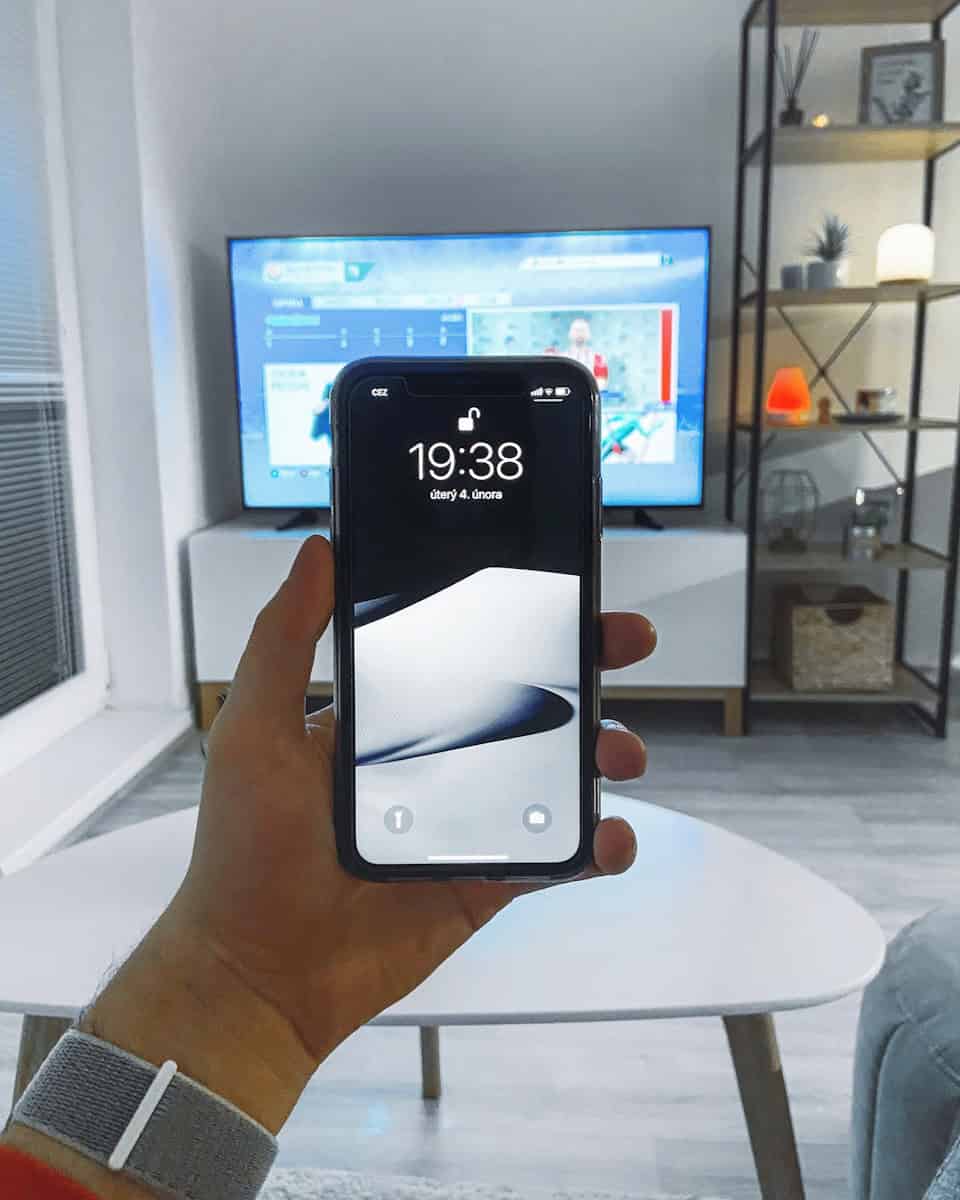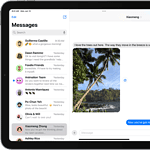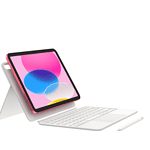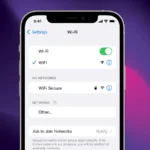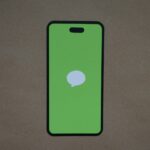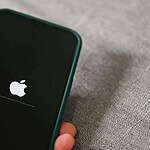Watching movies or playing games on a tiny phone screen can get old fast. Luckily, you can easily share your phone‘s screen on your TV for a better viewing experience. You can connect your iPhone or Android phone to your TV using wireless options like AirPlay and Chromecast, or with a simple HDMI cable adapter.
Most modern TVs now come with built-in features that make connecting your phone simple. iPhones work great with Apple TV or AirPlay 2-compatible smart TVs, while Android phones can screen mirror to almost any TV with Chromecast built-in. Even if you have an older TV, there are still several ways to connect your phone using adapters or streaming devices.
Getting your phone content on the big screen opens up new possibilities – from watching family photos during gatherings to enjoying Netflix on a larger display or giving presentations without a computer. The setup process takes just minutes and enhances your viewing experience significantly.
Use a Wired Connection (HDMI or USB-C)
The simplest way to connect your phone to your TV is with a physical cable. Most modern TVs have HDMI ports, and you can buy an adapter that plugs into your phone on one end and into the HDMI cable on the other. Here’s how it works:
- For iPhone: You’ll need a Lightning to Digital AV Adapter. Plug it into your iPhone, connect it to an HDMI cable, and then plug the HDMI cable into your TV.
- For Android: Many Android phones support USB-C to HDMI. Grab a USB-C to HDMI cable, plug it into your phone and TV, and you’re ready to go.
Once connected, your TV should automatically detect the signal and mirror your phone’s display. If not, switch the TV’s input to the correct HDMI port. This method is great for watching movies, playing games, or showing off vacation photos with minimal lag.
Connect Wirelessly with Screen Mirroring or Casting
If you prefer to go wireless, both iPhone and Android devices offer easy screen mirroring and casting options.
For iPhone: Use AirPlay
AirPlay makes it simple to beam content from your iPhone to your Apple TV or any AirPlay 2-compatible smart TV.
- Make sure both your iPhone and TV are on the same Wi-Fi network.
- Open Control Center on your iPhone.
- Tap “Screen Mirroring.”
- Select your TV from the list.
Your iPhone screen will appear on your TV almost instantly. You can also use AirPlay directly from apps like YouTube, Photos, and Apple Music by tapping the AirPlay icon.
For Android: Use Chromecast or Miracast
Most Android phones support casting either through Google Cast (Chromecast) or Miracast (built into many smart TVs).
Chromecast:
- Plug a Chromecast device into your TV if it’s not already built-in.
- Make sure your phone and Chromecast are on the same Wi-Fi network.
- Open a compatible app (YouTube, Netflix, etc.).
- Tap the Cast icon and choose your Chromecast.
Miracast:
- Go to your phone’s display settings and look for a feature like “Screen Cast” or “Wireless Display.”
- Select your TV from the available devices.
- Approve the connection on your TV if prompted.
With Chromecast and Miracast, you can stream videos, mirror your screen, or even use your TV as a giant display for games and presentations.
Use Streaming Devices and Smart TVs
If you have a smart TV or a streaming device like Roku, Fire TV Stick, or Apple TV, connecting your phone is even easier.
- Roku: Download the Roku app on your iPhone or Android. Use it to cast videos, photos, or mirror your screen.
- Fire TV Stick: Android phones can use “Cast” features natively, while iPhone users can install apps like AirScreen to enable AirPlay support.
- Apple TV: As mentioned earlier, AirPlay is built-in and seamless for iPhone users.
Many smart TVs also come with casting support pre-installed, eliminating the need for additional hardware.
Connect via DLNA Apps
DLNA (Digital Living Network Alliance) allows you to stream content from your phone to your TV over Wi-Fi. Many smart TVs support DLNA, and there are plenty of apps that can help, such as:
- Plex
- BubbleUPnP (Android)
- MCPlayer (iPhone)
These apps let you browse your phone’s media library and stream photos, videos, and music directly to your TV.
Key Takeaways
- Both iPhones and Android phones can connect to TVs wirelessly or with cables depending on your TV’s capabilities.
- Make sure your phone and TV are on the same Wi-Fi network for wireless screen mirroring to work properly.
- HDMI adapters offer a reliable wired connection option when wireless methods aren’t available or are experiencing issues.
Understanding Screen Mirroring and Casting
Whether you go with a cable, a wireless connection, or a streaming device, it’s easier than ever to connect your iPhone or Android phone to your TV. Wired methods offer reliability and minimal lag, while wireless options give you flexibility and convenience. Whichever method you choose, you’ll be enjoying your favorite content on the big screen in no time.
Connecting your phone to your TV opens up new ways to enjoy videos, photos, and apps on a bigger screen. Both iPhones and Android devices offer simple methods to share content on TVs.
What Is Screen Mirroring?
Screen mirroring displays your phone’s entire screen on your TV. Whatever you see on your phone appears on your TV screen in real-time. This technology lets you show photos, play games, browse websites, or use any app on a larger display.
To use screen mirroring on an iPhone, you’ll need to use the AirPlay feature. Just open Control Center, tap “Screen Mirroring,” and select your TV from the list.
Android users have similar options. Samsung devices include a feature specifically called Screen Mirroring. Other Android phones may call it Cast, Smart View, or something similar.
Both systems require your TV and phone to be on the same Wi-Fi network for the connection to work properly.
Differences Between Screen Mirroring and Casting
While people often use the terms interchangeably, screen mirroring and casting work differently. Screen mirroring shows everything on your phone screen, while casting sends specific content to your TV.
When you cast content, your phone acts like a remote control. The TV directly streams the content from services like YouTube or Netflix. This means you can still use your phone for other tasks while watching a video on the TV.
Casting typically offers better video quality because it streams directly to your TV. It’s great for watching movies or shows.
Screen mirroring is better for:
- Showing photos or presentations
- Browsing websites together
- Playing mobile games on a big screen
- Using apps that don’t support casting
Casting works best for:
- Watching videos without draining your phone battery
- Getting higher quality video playback
- Using your phone for other tasks while watching TV
Prerequisites for Connecting Your Phone to Your TV
Before connecting your phone to your TV, you need to check a few things first. Having the right equipment and setup will make the process much smoother.
Compatibilities and Requirements
Different methods require specific hardware or software to work properly. For iPhones, you’ll need an Apple TV or an AirPlay 2-compatible smart TV to connect wirelessly. Android phones can connect to TVs that support Chromecast or have Android TV built in.
Most modern smartphones (made after 2015) support screen mirroring. Your TV should also be compatible – look for features like Chromecast built-in, AirPlay 2, or Miracast.
Some older TVs might need extra hardware like:
- Streaming devices (Roku, Fire TV Stick, Apple TV)
- Wireless display adapters
- HDMI dongles (like Chromecast)
Check your phone and TV manuals to confirm compatibility before trying to connect them.
Wi-Fi Connectivity
Both your phone and TV must be connected to the same Wi-Fi network for wireless casting to work. This is essential for methods like AirPlay, Chromecast, and most smart TV apps.
Your Wi-Fi should be stable with enough bandwidth for streaming. Poor connections cause lag, buffering, or disconnections during playback.
To check if devices are on the same network:
- Go to your phone’s Wi-Fi settings
- Note the network name
- Check your TV’s network settings
- Confirm both show the same network name
If your TV isn’t Wi-Fi enabled, you’ll need to use a wired connection method instead.
HDMI Port and Cable Availability
Most TVs have multiple HDMI ports that allow direct connections from phones. You’ll need the right cable or adapter based on your phone model.
For iPhones, you’ll need:
- Lightning to HDMI adapter (for iPhone 5 through iPhone 14)
- USB-C to HDMI adapter (for iPhone 15 and newer)
For Android phones, options include:
- USB-C to HDMI cable (newer phones)
- Micro USB to HDMI adapter (older phones)
- SlimPort adapter (some models)
Plug your adapter into your phone, then connect an HDMI cable from the adapter to your TV. Make sure to note which HDMI port you’re using and select that input on your TV.
Check that your TV remote has working batteries so you can switch inputs easily.
Using Apple AirPlay to Connect iPhone to TV
AirPlay offers a simple way to stream videos, photos, and music from your iPhone to your TV screen. This wireless technology works with Apple TV and many newer smart TVs that have AirPlay built in.
Setting Up AirPlay on Your iPhone
To use AirPlay, make sure your iPhone is updated to the latest iOS version. This helps avoid connection problems. Both your iPhone and TV must be connected to the same Wi-Fi network to work properly.
Turn on AirPlay by swiping down from the top-right corner of your iPhone screen to open Control Center. Look for the screen mirroring button (it looks like two rectangles stacked). If you don’t see it right away, you might need to add it in Settings.
For the best streaming quality, keep your iPhone close to your TV. Walls and other objects can weaken the signal and cause buffering issues.
Connecting to an Apple TV or a Smart TV with Built-in AirPlay
Once AirPlay is ready on your iPhone, you can connect to your TV. If you have an Apple TV, make sure it’s turned on and connected to your home network.
For smart TVs with built-in AirPlay support, you may need to enable the feature first. Check your TV’s settings menu – usually under “Network” or “General” options.
Tap the screen mirroring button in Control Center, then select your TV from the list that appears. Your iPhone screen will now show on the TV.
Some smart TVs from Samsung, LG, Sony, and Vizio now come with AirPlay 2 built in, making it easier to connect without extra devices.
Using Google Chromecast with Android and iPhone
Google Chromecast allows you to easily mirror your phone screen to your TV. This small device plugs into your TV’s HDMI port and connects to your home Wi-Fi network, creating a bridge between your mobile devices and your big screen.
Chromecast Setup on Your Device
Setting up Chromecast on your phone is quick and straightforward. First, plug your Chromecast into your TV and download the Google Home app on your iPhone or Android device.
Make sure your phone and Chromecast are connected to the same Wi-Fi network. Open the Google Home app and tap the “+” icon to add a device. The app will search for nearby devices.
When your Chromecast appears, select it and follow the on-screen instructions. The TV will display a code – confirm this matches what’s shown on your phone.
For iPhone users, you’ll need to turn on both Bluetooth and local network access for the Google Home app in your settings.
Casting Content With Google Home App
Once your Chromecast is set up, casting content is easy. Many popular apps like YouTube, Netflix, and Spotify have built-in cast buttons that look like a TV with Wi-Fi waves.
For Android users, casting is typically smooth with most apps. Simply tap the cast icon and select your Chromecast device from the list.
iPhone users can cast to Chromecast too, though some apps work better than others. For best results, use apps that specifically support Chromecast.
To mirror your entire screen, open the Google Home app, select your Chromecast device, and tap “Cast my screen.” This works well for sharing photos, browsing websites, or playing games on your TV.
Connecting Phones Using HDMI
Connecting your phone to a TV with HDMI lets you enjoy videos, photos, and apps on a bigger screen. Both iPhone and Android users have multiple options that work with most modern TVs.
Using an HDMI Adapter for Your Phone
Different phones need different adapters to connect to TVs. For iPhones, you’ll need a Lightning to HDMI adapter, often called a Lightning Digital AV Adapter. This small device plugs into your phone’s charging port.
For Android phones, the solution depends on your device. Most newer models use USB-C to HDMI adapters if the phone supports video output. Older Android phones might need MHL (Mobile High-Definition Link) or SlimPort adapters.
Once you have the right adapter:
- Plug the adapter into your phone
- Connect an HDMI cable to the adapter
- Plug the other end into your TV
- Select the correct HDMI input on your TV
Your phone screen should appear on the TV within seconds.
Connecting via HDMI Cable and Port
Finding the right port on your TV is the first step. Most TVs have multiple HDMI input ports on the back or side panels. These rectangular ports are clearly labeled as HDMI.
For the connection, you’ll need:
- A standard HDMI cable
- The correct adapter for your phone
- Your TV remote to switch inputs
After connecting your adapter to the phone, plug one end of the HDMI cable into the adapter and the other end into an available HDMI port on your TV. Note the port number (HDMI 1, HDMI 2, etc.).
Use your TV remote to select the matching HDMI input. Some Android phones may need you to adjust display settings on the phone for the best picture. Many modern cables, like Amazon Basics USB-C to HDMI cables, work well with compatible Android devices.
Wireless Display Solutions for Non-Smart TVs
Even if you have an older TV without smart features, you can still wirelessly connect your phone to it. Several affordable devices and methods make this possible without buying a new TV.
Dongles and Wireless Display Adapters
If your TV isn’t smart but has an HDMI port, you can add wireless capabilities with a streaming dongle. Popular options include:
- Chromecast: Plugs into your TV’s HDMI port and lets you cast content wirelessly from your phone
- Amazon Fire TV Stick: Works with both Android and iOS devices
- Roku Streaming Stick: Offers screen mirroring for compatible phones
These devices cost between $30-$50 and are easy to set up. Just plug them into your TV, connect to Wi-Fi, and follow the setup instructions.
For iPhone users, an Apple TV box works best as it supports AirPlay. This lets you mirror your iPhone screen to any TV with an HDMI port.
Mirroring Apps and Wireless Display Methods
Several apps can help bridge the gap between your phone and non-smart TV when used with the right hardware:
For Android users:
- Google Home app works with Chromecast devices
- Screen mirroring through Miracast on compatible TVs
- Third-party apps like AllCast or LocalCast
For iPhone users:
- AirPlay works with Apple TV or AirPlay-compatible devices
- Make sure your phone is on the same Wi-Fi network as your streaming device
For completely non-smart TVs without HDMI ports, you might need a wireless HDMI kit. These kits include a transmitter that connects to your phone and a receiver that plugs into your TV’s video inputs.
Alternative Methods to Mirror Your Phone’s Screen
Beyond standard mirroring options, several alternative methods can help you display your phone content on a larger screen. These solutions work with different devices and offer varying features depending on your setup.
Using Roku for TV Connection
Roku devices offer simple ways to mirror both iPhone and Android screens. For Android users, Roku supports screen casting through the built-in cast feature available in most Android phones.
To connect an iPhone to Roku:
- Make sure both devices are on the same Wi-Fi network
- Download the Roku app on your iPhone
- Open the app and select “Media”
- Choose the content you want to display
Android phone connection is even easier:
- Open Settings
- Select “Display” or “Connected devices”
- Tap “Cast screen” or “Screen mirroring”
- Select your Roku device from the list
Roku supports most popular streaming apps directly, so sometimes using the Roku channel is better than mirroring your entire screen.
Third-party Mirroring Solutions
When built-in options don’t work, third-party apps can bridge the gap. Apps like DoCast for iPhone can help connect to devices that don’t support AirPlay natively, like many Android TVs.
Popular third-party mirroring apps include:
- AllCast
- LocalCast
- AirScreen
- ApowerMirror
These apps work by creating a connection between your phone and TV through your Wi-Fi network. Most offer free versions with basic features and premium options with better quality.
For non-smart TVs, HDMI adapters provide a direct physical connection. Simply plug the adapter into your phone and connect an HDMI cable between the adapter and TV for instant mirroring.
Applications for Screen Mirroring
Screen mirroring apps let you view your phone’s content on a larger TV screen. These tools support various activities from watching movies to playing mobile games with better visuals.
Streaming Media and Video Services
Several apps make it easy to send streaming content from your phone to your TV. The Screen Mirroring app for iPhone displays your screen on smart TVs with excellent quality and minimal lag. This works great for watching Netflix, Disney+, or other streaming platforms.
For Android users, free options like LetsView and AirDroid Cast work well when your phone and TV share the same Wi-Fi network. These apps don’t require extra hardware.
iPhone users can tap the Screen Mirroring icon (looks like overlapping boxes) in the Control Center, then select their TV from the list that appears. Most newer smart TVs support this feature automatically.
Many TVs now come with built-in casting abilities that connect directly with streaming apps on your phone.
Sharing YouTube Videos on TV
Watching YouTube videos on a TV screen provides a better viewing experience than on a small phone. The Google TV app offers a simple way to cast videos.
Steps to share YouTube videos to TV:
- Open the YouTube app on your phone
- Tap the cast icon (looks like a TV with a Wi-Fi signal)
- Select your TV from the device list
- Choose your video and it will play on the TV
For TVs with Chromecast built-in, iPhone users can try the DoCast app. This app bridges the gap between Apple devices and Android TVs.
YouTube casting is especially helpful for watching tutorials, music videos, or sharing funny clips with friends and family in the same room.
Playing Games on a Bigger Screen
Mobile games look and feel different when played on a TV screen. Screen mirroring transforms casual gaming into a more immersive experience.
Benefits of gaming via screen mirroring:
- Larger display makes game details more visible
- Better for multiplayer games when friends are present
- Reduces eye strain during longer gaming sessions
Racing games, puzzle games, and adventure titles benefit most from the larger screen. Some games even allow you to use your phone as a controller while the game displays on TV.
There is a slight delay (lag) when mirroring games, which might affect fast-paced action games. Keeping your phone close to the TV and using a strong Wi-Fi connection helps reduce this lag.
Troubleshooting Common Connection Issues
Connecting your phone to your TV sometimes hits snags that can be frustrating but are often simple to fix. Most problems stem from network issues or settings that need adjustment.
Dealing With Connectivity Problems
If your TV won’t connect to your phone, first check that both devices are on the same Wi-Fi network. This is the most common issue and easy to fix.
For iPhone users trying to use AirPlay, make sure your Apple TV or smart TV is AirPlay 2-compatible. Samsung users should ensure Smart View is enabled on both devices.
Try these quick fixes when connection fails:
- Restart both devices – sometimes the simplest solution works best
- Update your apps and system software to the latest version
- Check your Wi-Fi signal strength – move closer to the router if needed
- Toggle airplane mode on and off to reset connections
If your TV says “no device found”, try restarting your router. Sometimes network issues block device discovery.
Solving Video and Audio Sync Errors
Video playing but audio lagging? This common issue usually has simple fixes. First, check your internet speed – streaming requires stable bandwidth.
For better sync, try these tips:
- Lower the video resolution if your network can’t handle high-definition
- Close background apps on your phone to free up resources
- Update your TV’s firmware to fix known bugs
- Try a wired connection with an HDMI adapter for more stability
Bluetooth audio delays are common with wireless setups. If using external speakers, try connecting them directly to the TV instead of through your phone.
For Samsung Smart View users, making sure both the TV and phone have the latest software updates often resolves sync issues automatically.
Frequently Asked Questions
Connecting phones to TVs offers various options depending on your devices and preferences. Many solutions work without cables, while others require specific adapters or apps.
What methods are available to wirelessly mirror content from an iPhone to a smart TV?
iPhones can connect wirelessly to TVs using AirPlay. This feature works with Apple TV and AirPlay 2-compatible smart TVs.
To use AirPlay, make sure both your iPhone and TV are on the same Wi-Fi network. Then open Control Center on your iPhone by swiping down from the top-right corner.
Tap the Screen Mirroring icon and select your Apple TV or compatible smart TV from the list. Your iPhone screen will now display on your TV.
Can I use Bluetooth to connect my phone to a TV, and if so, how?
Bluetooth alone typically cannot mirror your phone screen to a TV. It works mainly for audio streaming rather than video content.
Some TVs support Bluetooth connections for playing music from your phone, but not for displaying videos or mirroring your screen. For full screen mirroring, Wi-Fi based options like AirPlay, Chromecast, or HDMI cables work better.
Is there a way to cast content from an Android phone to a TV without using Wi-Fi?
Yes, you can use a physical connection with an HDMI adapter. Most Android phones use USB-C or micro-USB ports that can connect to TVs with the right cable.
You’ll need a USB-C to HDMI adapter or MHL adapter, depending on your phone’s port. Connect one end to your phone and the other to an HDMI port on your TV.
After connecting, switch your TV to the correct HDMI input source using your remote. Your phone screen should then appear on the TV screen.
What are the steps to mirror an Android phone’s display onto a smart TV?
First, check that both your Android phone and smart TV are connected to the same Wi-Fi network. This is key for wireless mirroring to work properly.
On your Android phone, pull down the notification shade and look for the Screen Cast, Smart View, or Screen Mirroring option. The name varies by phone brand.
Tap this option and select your smart TV from the list of available devices. Your phone screen should now appear on the TV within seconds.
Can I screen mirror my iPhone to an Android TV, and what are the requirements?
Yes, iPhones can connect to Android TVs, but you’ll need a third-party app since AirPlay isn’t built into Android TVs. Many Android TVs have built-in Chromecast functionality.
You can download apps like DoCast from the App Store that enable casting to Chromecast-enabled devices. These apps create a bridge between your iPhone and Android TV.
The main requirement is that both devices must be connected to the same Wi-Fi network. Some apps may require in-app purchases for full functionality.
Are there any free solutions for mirroring an iPhone to an Android TV?
Several free apps in the App Store let you mirror your iPhone to Android TVs. Apps like DoCast offer basic functionality without payment.
Another option is using the HDMI adapter method, which requires a one-time purchase of a Lightning to HDMI adapter. After buying the adapter, you won’t need to pay for any subscription services.
Some smart TVs also have manufacturer-specific apps that offer free mirroring. Check your TV manufacturer’s app store to see if they provide a free solution for iPhone connections.

